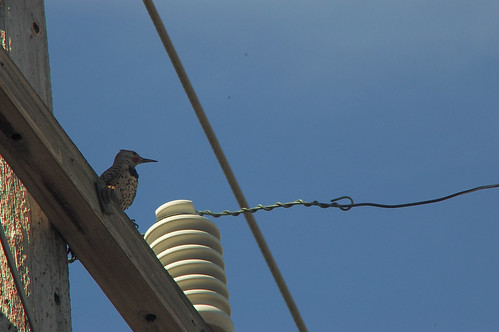In the world of birds, late fall is a time of lean feeding options. Here on the Hill, this means an increase in action at backyard birdfeeders. One frequent feeder visitor is our neighborhood’s most common woodpecker: the northern flicker. Unlike smaller birds such as chickadees and juncos, flickers can demolish a feeder’s food stash alarmingly quickly—but it’s fun to watch them eat.
The northern flicker is brownish overall, with black bars on the back and black spots on the front. It has a dapper black crescent on the breast and red markings around the head and wings. (Some individuals, called yellow-shafted northern flickers, have yellow rather than red on the wings.) In the wild, flickers forage both on trees and on the ground, locating prey by sight or sound.
When you see a flicker on a feeder, take the opportunity to observe its anatomy up close. Like many other woodpeckers, flickers have thick tails that they use for extra support as they maneuver their bodies along tree trunks. These tails also come in handy as the birds hang on birdfeeders—especially feeders that swing and spin
If you can get close while a flicker eats, you may see flashes of its exceptionally long tongue. This tongue is barbed and sticky, perfect for capturing insects—and pretty effective at demolishing suet cakes, too. The flicker’s skull is specially shaped so its tongue, when not in use, can furl around the eye socket and the back of the head. The shape of the flicker’s skull also provides a cushioning effect so the bird’s brain doesn’t get damaged during drumming.
Flickers are common in backyards and parks throughout the neighborhood. Yellow-shafted northern flickers are relatively uncommon in our region, but I have occasionally spotted them at the Washington Park Arboretum.
Interested in learning more?
- For information and fun facts, check out the northern flicker’s page at the Cornell Lab of Ornithology.
- Hear the song, call, and drumming pattern of the northern flicker at the Macaulay Library of Natural Sounds.
- Check out this New Scientist article about the woodpecker’s skull structure and its influence on the design of shock absorbers.
- If the northern flicker’s drumming is annoying you or damaging your house, the Seattle Audubon Society has some helpful hints here.
Previous Aviary Posts
- Hill serves as winter destination for dark-eyed juncos
- This bird is about to debut a whole new look for fall
- The Bard, the birds and the battle for Hill gardens
- More…
Melissa Koosmann is a freelance writer and resident of Capitol Hill. She writes about education, culture, and nature — and, sometimes, birds for CHS.




We’ve been seeing them in our yard all the time, since early summer. There seems to be a family of 3 living in the area of 18th and Spring. They love to pick over the lawn for bugs along with the flocks of starlings, which makes them look like some sort of chaperone. Their feathers are amazingly beautiful! :-)
Cool article, thanks!
(my not-great photo of the Flickr in the neighborhood in February, http://www.flickr.com/photos/mookmonkey/5489586325/in/photos )
Here’s a photo of two of them hanging off my suet feeder in the backyard.
http://www.leahcutter.com/2012/08/going-to-the-birds/dscn263
This summer I could watch them use the birdbath, then fly up to the roof, spread their wings out and sun themselves.
Here’s actually a post I did, with lots of pictures of the birds at my feeders:
http://www.leahcutter.com/2012/08/going-to-the-birds/#more-1
Cool stuff. Thanks to both of you for sharing.
I am about 3 1/2 blocks from Volunteer park, and have had a yellow shafted flicker in our backyard. We mostly have the greedy red shafted, but I love them!
Cool! I haven’t seen yellow-shafted flickers in that part of the neighborhood, but I’m glad to hear that they’re around.
I enjoyed your article, as always. Also appreciated the link to the Audubon Society helpful hints.
Thanks!